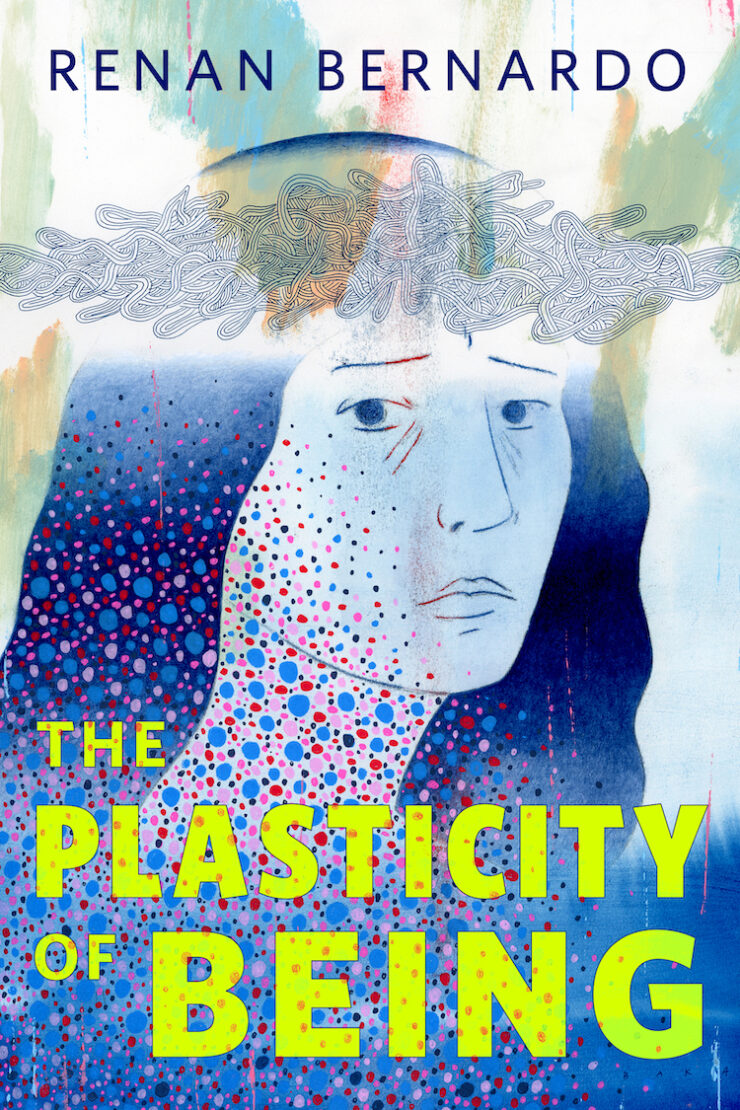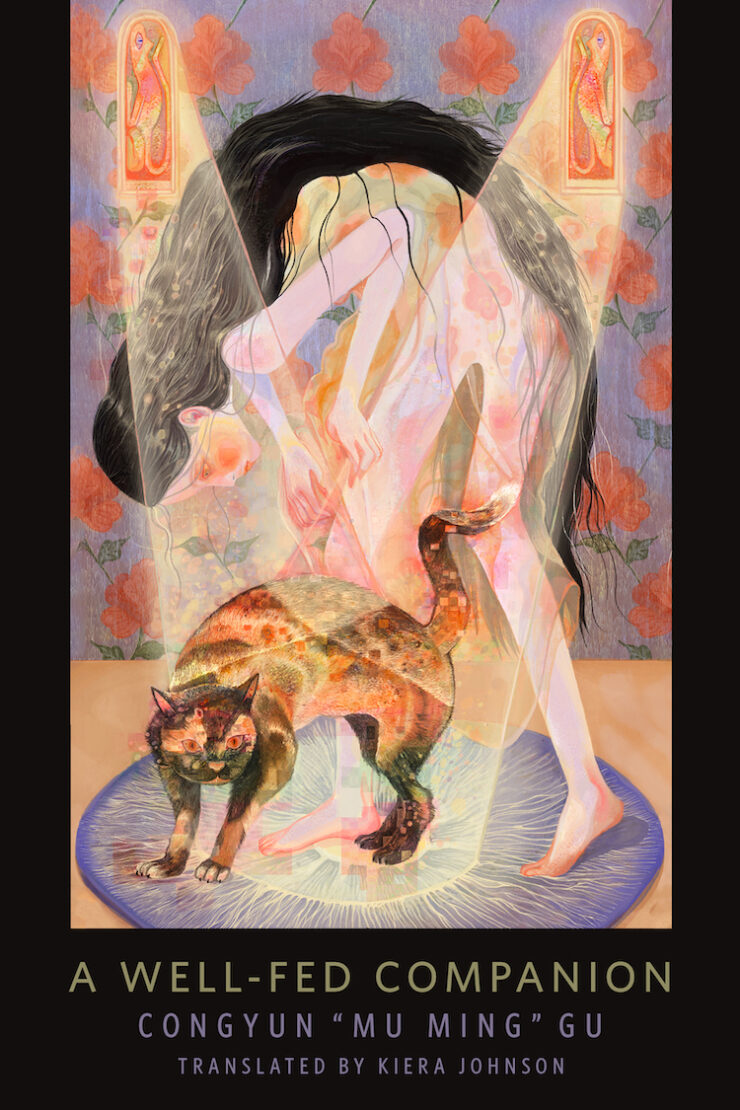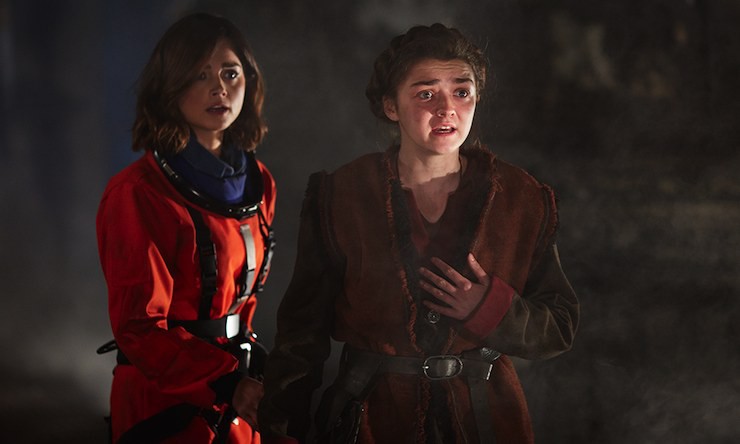Peter Capaldi was a part of the Whoniverse long before he became the Doctor. So why has his face shown up again? Why did the Doctor pick that face? We finally get an answer to that question on “The Girl Who Died.”
Summary
Clara is floating out in space with a little creature crawling up inside her suit; the TARDIS is currently under attack, so it’s taking the Doctor longer than usual to get to her. Once he finally picks her up, the TARDIS lands on Earth and duo are captured by Vikings. The Doctor claims that his sonic sunglasses are a source of great power, but the Vikings break them. He and Clara are handcuffed and taken back to the village, where the Doctor then pretends to be Odin, dangling a “magic” yo-yo at them. His ruse doesn’t play because Odin appears in the sky and tells the warriors of the village that he intends to reward them for their bravery, by allowing them into Valhalla. A bunch of creatures in mecha suits appear, and they beam the best warriors out. Clara is in the process of getting a village girl named Ashildr to undo her handcuffs with half of the sonic sunglasses, and the mechas notice the technology and beam the two of them up as well.
The “Odin” they saw ends up murdering the village warriors so that he can drink up their adrenaline and testosterone. He turns out to be one of the Mire, a violent warrior species who absorb the hormones of the best warriors across the universe for their own gain. Ashildr is angry that this happened to all the good fighters in her village, and she declares war on the Mire on half of her people, just as Clara was convincing them to leave quietly. The Mire accept, and tell them that battle will commence in 24 hours, sending Ashildr and Clara back. Clara tells the Doctor what happened, and he tells the villagers to flee, but they are Vikings and want to fight. The Doctor plans to leave, but hears a baby crying, and decides to stay after translating its wails to Clara. He is faced with having to prepare a town of only farmers and fishermen to go to war. The townspeople are predictably terrible at fighting, but Clara insists that the Doctor come up with a plan to save them. He speaks to Ashildr—who makes beautiful puppets and is fond of storyteling—and she explains her own desire to stay with her people, telling the Doctor that this is the only place she has ever belonged.
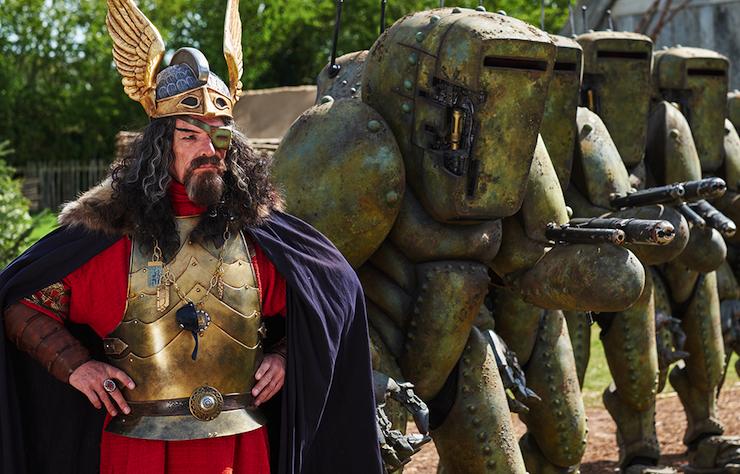
Suddenly, the Doctor remembers that the baby’s cries had included the term “fire in the water,” and he realizes that it was in reference to electric eels in the village water. He devises a plan where the townspeople create a diversion by pretending to party when the Mire show up, then hook metal wires into their helmets and short them out using the eels. Once they obtain a helmet, Ashildr uses her storytelling abilities and puppets and the Mire’s technology to make them think that they’re fighting a great dragon. They flee, leaving “Odin” behind, and the Doctor shows him what they were really running from; he has the whole event recorded and threatens to upload it to a Galactic Hub if they don’t retreat permanently. The Mire leave, and the townspeople celebrate until they find that Ashildr died due to interfacing with the Mire tech.
The Doctor is horrified by this turn of events, apologizing to the village before ducking away. Clara asks him what happened, and the Doctor tells her that he’s tired of always losing people that matter to him. Then he spots his reflection and has a revelation—his face is the face of Caecilius (from “The Fire of Pompeii”) and he received it to remind himself of the important lesson he learned from Donna Noble during that adventure: that he didn’t have to save everyone everywhere he went, just someone, even if it seems to be against the rules. He rewires a chip from the Mire helmet and melds it with Ashildr, bringing her back to life. She thanks him, but as they leave, the Doctor explains to Clara what that chip has done to Ashildr: It has made her effectively immortal, repairing her perpetually.
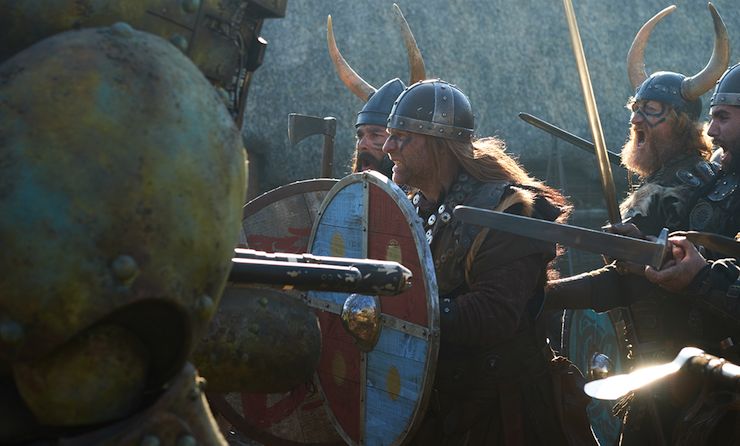
The episode ends as we watch time pass around Ashildr, her expression turning from joy to despair and anger.
Commentary
On the one hand, this episode drove me nuts. It is 90% setup, and that setup itself isn’t all that exciting. The Viking village fighting the Mire doesn’t feel like it has high stakes attached to it at all, and that’s because it doesn’t; it’s a prop to give a reason for Ashildr’s death, so that the Doctor can revive her and create the next episode. The fact that the village is a Viking one feels like that afterthought; there’s very little about them that actually indicates “Viking,” other than their belief in Valhalla and Norse gods. Otherwise, it’s a village of people in tunics with swords. It could be any European town from that era, if the episode had needed to play it that way. Maybe the BBC wanted to reuse some costumes from Merlin, or something? Obviously, they needed a reason for the village battle against the Mire to be unbalanced, but the stock “we only have farmers to fight and they’re never held swords!” trope is unbelievably overused (see the aforementioned Merlin), and if you’re not going to make any interesting commentary on the plot, then its use is just boring.
Though Maisie Williams is always a joy to watch, Ashildr’s character is thin on the ground. We know that she’s honorable like the rest of her people, and that she loves her father. The rest of the character is given to us in an info-dump scene where the Doctor finds out that she loves telling stories and building puppets, and that she’s not masculine enough to hang with the boys, but not feminine enough to hang with the girls. And the only reason we need to know any of these things is to make her role in the battle against the Mire clear. It’s a shame that it couldn’t have been worked in much sooner, that she couldn’t have bonded with Clara some more.
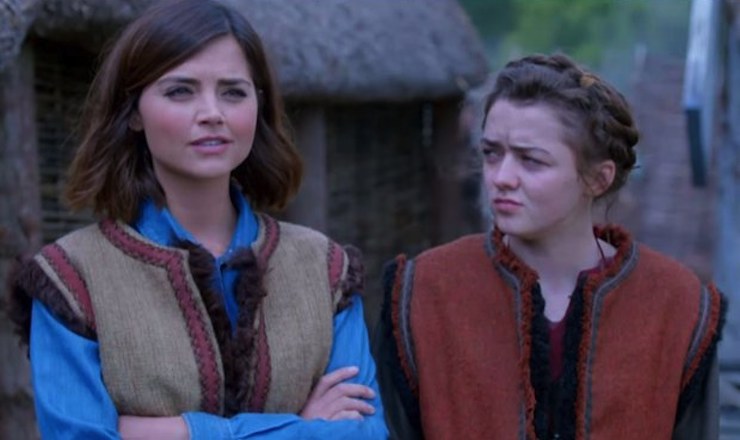
On the other hand… the episode ends on several perfect moments, and answers some key questions that we’ve been asking since Capaldi’s casting. It’s clearly playing into the season arc as well, when we take a long view of Ashildr’s position in the narrative. Specifically, the Doctor refers to her as a “hybrid”: this is what Davros called the new race of Daleks that were created when the Doctor handed over his regeneration energy in “The Witch’s Familiar.” So Ashildr is either a part of the season arc, or designed to teach the Doctor something about what it means to be a hybrid as a way of setting up the season finale. When discussing how immortality will affect Ashildr, he tells Clara, “Time will tell; it always does,” which is a very specific callback to the Seventh Doctor story “Remembrance of the Daleks,” when Skaro is (seemingly) destroyed. So, this tie between Ashildr and the new Daleks is pronounced, meant to catch our attention.
While the Doctor’s ability to speak baby has always been good for a laugh in the past, I enjoyed its use here as something far more somber. It makes the trick come off like more of a true talent form the Doctor’s perspective, not just a clever way to make good jokes. In addition, all of the conversation between the Doctor and Clara in this episode are on-point, as usual. His difficulty with constantly losing people is walking a similar line that the Tenth Doctor ran into by the end of his tenure, something that started building up in the Ninth Doctor’s run. But Capaldi’s difficulty is played from a different angle; the pain he is feeling is wrapped up in helplessness that comes with having great power but being unable to use it when it matter most (rather than a build up of PTSD following the Time War). Again we’re seeing hints of what this might mean for Clara’s departure, and we can only guess at what that will do to the Doctor.
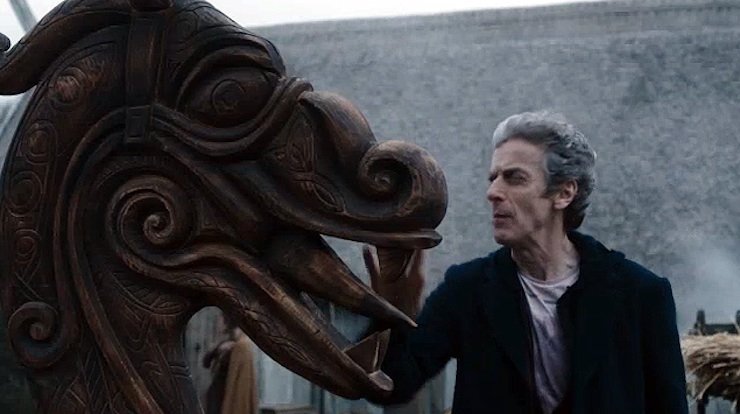
The reliance on storytelling as a legitimate battle technique was also inspired, a literal take on how psychology plays into warfare. Ashildr’s ability to save her people as a young woman, through her own strength as a storyteller, is exactly the kind of turn that makes Doctor Who such a unique and special piece of science fiction. In a show that’s all about a man who calls himself a Doctor, a hero who carries no weapons, and prides himself on helping people, the idea of fighting a war with stories and ideas is precisely on message.
Steven Moffat made mention last year that he had spoken with Russell T. Davies about the use of Capaldi on the show, and that Davies had come up with a reason as to why the Doctor would have that familiar face. Moffat said the he intended to use that reason, and promised that it would come up in the show, and here we have it. The choice is a beautiful one, and a very classic sort of Davies move; most of Moffat’s twists rely on complex plotting, but Davies’ often relied on deep emotion. And that is precisely what we have here: a callback to one of the most devastating adventures that the Doctor had in recent memory, devastating for the fact that he almost didn’t do what he was born to do. It took Donna Noble to remind him that it’s not always about saving the universe, or the world, or even the city; that the act of saving the single life was just as important. The idea that the Doctor subconsciously filtered that into his regeneration, that he knew he would need the reminder this time around, is a gorgeous piece of storytelling.
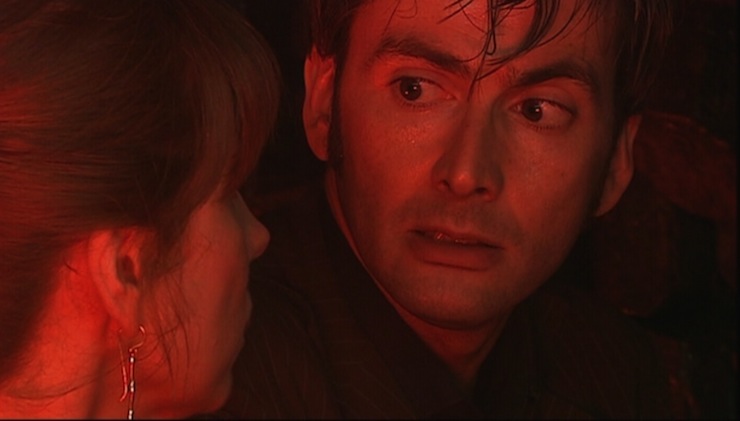
So, an incredible final fifteen minutes with a weak opening. I dearly hope that the second part of the story makes up for it with interest, and trust that Ashildr’s arc will be expanded well going forward.
Here are the other Easter Eggs:
- HE SAID “REVERSING THE POLARITY OF THE NEUTRON FLOW.” HE SAID IT. HE SAID THE WHOLE THING.
- The Doctor used a yo-yo last season to test gravity on the moon, but pretending that it is “magic” harkens back to the Fourth Doctor’s time with companion Leela–who also believed that yo-yos were magical.
- The Doctor consults his 2000 Year Diary, an update of the 500 Year Diary kept by the Second Doctor.
Emmet Asher-Perrin may eventually stop crying over seeing Ten and Donna again. You can bug her on Twitter and Tumblr, and read more of her work here and elsewhere.


